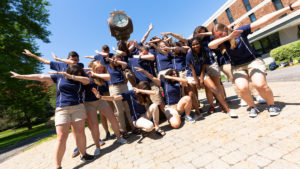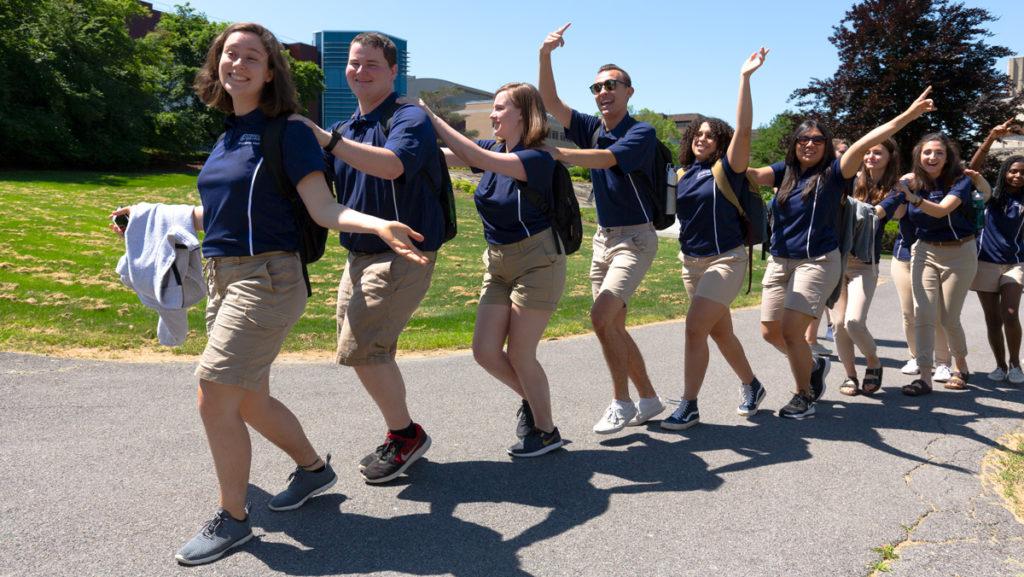Ithaca College is changing the way it is running summer orientation for freshman students, causing responsibilities to shift for the student employees who help organize the programming — including orientation leaders and resident assistants.
The new orientation model is going into effect this coming summer, and orientation will be held for eight consecutive days for the incoming freshman class instead of over multiple dates throughout the summer. Because of this new model, the Department of New Student and Transition Programs will hire 100 individuals for its orientation staff this year, consisting of 80 orientation leaders and 20 orientation mentors, as opposed to the 20 orientation leaders and one orientation assistant hired in previous years, said Kevin Perry, associate director of the Department of New Student and Transition Programs. Previously, the department was looking to hire 125 individuals for its orientation staff, but Perry said it was a challenge to do so, so the goal will be to hire 125 individuals in future years.
Resident assistants are also expected to be on campus and assist with orientation, causing them to return to campus four days earlier than their original start time, Dean of Students Bonnie Prunty said. RAs will also be receiving an increase in their compensation as a result of the budget proposal submitted to the president’s office last year, as well as new responsibilities that come with the new orientation model. However, some RAs said they think that the positions have not been clearly outlined, so some are unsure about heading into their newly redefined roles.
RAs were recently informed that their compensation has been increased due to a proposal that RAs sent to the president’s office last year. Prunty said RA compensation has been raised to 100 percent of room and board for returning RAs and 80 percent for new RAs. The proposal submitted by RAs last year requested a raise from the previous 75 percent of room and board coverage for new RAs and the 91.9 percent for returning, Prunty said.
Perry said there has been some difficulty recruiting orientation staff members because of the conflicting leadership positions on campus that are training at the same time as orientation staff, like RAs, who will be completing their training at the same time as the orientation staff. The deadline to apply for orientation staff was also extended, an extension that Perry said was in part to increase and diversify the pool of students applying. The goal is for every new student to be able to identify with someone they see on the orientation staff, Perry said.
“We are committed, and have always been committed, to ensuring that our orientation staff represents our diverse campus population,” Perry said.

Perry did not specify how many students applied for the position or how many were accepted. In addition to the new orientation leader position, RAs have also been tasked with new responsibilities during the orientation process.
The former orientation leader position consisted of advising small groups of incoming students at orientation and providing those students with any necessary guidance or information necessary, sophomore Aidan Glendon, a former orientation leader, said. Orientation leaders also assisted prospective students with their class scheduling. Perry said the new orientation staff positions were designed with many aspects of the previous orientation leader position, but the position will be treated as a new role with the adjustment to the new orientation model. Perry said one major difference between the new and old orientation roles is that in the new model, orientation leaders are not expected to be on-call at all times or be available to troubleshoot issues students may have.
Orientation mentors are also new positions being introduced to the new model. To hold this position, mentors are required to have held leadership positions on campus for a full semester. Perry said mentors will serve a supervisory role to orientation leaders and be a resource for them. Mentors will also serve as managers for the events that take place during orientation.
The decision to alter the orientation process was made to create a better sense of equity for all students, family and guests, Perry said. With the new orientation style, students and their families will not have to take a separate trip to Ithaca in the summer, which can be an expense some families cannot afford, and can instead make one trip right before move-in day. In addition, because orientation will now be in August, more departments, buildings and organizations will be open and active during the orientation process. Perry said specific departments on campus will have events planned for new students to participate in during the orientation process, like trivia nights in the library.
Sophomore Jessica Scarano, an RA in Lyon Hall, said she believes having all of the new students on campus at one time will assist in their adjustment to the college and help them form concrete relationships with their peers and RAs.
“I think the new orientation makes a lot of sense,” Scarano said. “It will put down a good foundation for these new students to form concrete relationships with one another right from the beginning.”
RAs have not yet received comprehensive information about what their positions at orientation will entail, raising some concerns. Sophomore Syona Ayyankeril, an RA in Upper Terraces, said some RAs have been frustrated by not having been notified about this change earlier. New RAs will move in August 9, and returning RAs will move in August 13.
“I don’t know whether or not we’re going to have that many extra responsibilities,” Ayyankeril said. “But it’s kind of a bummer to have to come back early.”
Perry said the payment has increased for orientation staff, so staff members will be able to make almost as much as they would in the former orientation style but still slightly less. Orientation leaders used to receive a stipend pay for their work over the summer but will be paid hourly during the new orientation model.
A Q&A sent to all RAs from the Office of Residential Life said that assisting and planning nightly events for new students to socialize with one another will be one of the main responsibilities of RAs during orientation. RAs will be guiding students around campus as well as hosting certain events. Sophomore Skylar Eagle, an RA in West Tower, said she does not believe RAs will have to do much extra work for the new orientation style, as the responsibilities during orientation will be similar to the work they complete during the year. She said she is excited to see how freshmen will adjust to the college with the new orientation style.
“I think the new orientation will be a positive thing for the college,” Eagle said. “The new model looks really cool, and it gives students a better chance to get to know the school before they’re thrown into the semester.”
Although some former orientation leaders have a strong connection to the former orientation format, some of them feel the new style will be more beneficial to incoming students, Glendon said.
“There will still be a similar amount of time for new OLs to train, so we know that new orientation staff will get the information and guidance that they need,” Glendon said. “The increase in the size of orientation staff will also make for some very exciting dynamics.”








